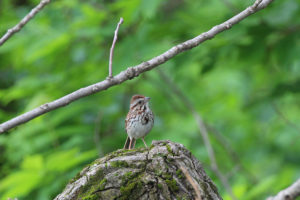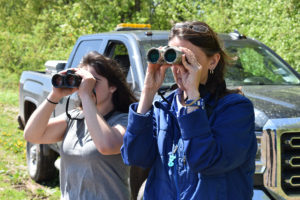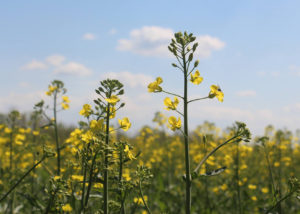Paige and I sit patiently in the truck. Peering out through our binoculars, we wait in suspense. It was two years ago now that I spotted a new Bald Eagle nest at the top of an old cottonwood tree on the field edge by the creek.
In previous years, we had observed chicks in this nest. Will this year be the same? Have we managed this land in a way that will give these birds the best chance to successfully raise their young?
In 1976, there was only one pair of Bald Eagles left in New York State. Pesticides such as DDT along with heavy metals and contaminated water and fish caused nest failures and near extirpation of eagles in New York. Through a ban on DDT and a reintroduction program, Bald Eagles were able to make a recovery. It is our actions, and our relationship to the land that created this history, good and bad.
The conservation of birds is valuable, but understanding the services birds provide to us is equally important. When we consider this perspective, our relationship to birds and agriculture becomes more complex than simply protecting a specific species like the Bald Eagle. The question is not only what can farmland provide to birds, but what might birds provide to farmland?
Consider the Red-winged Blackbird. In a planting of sweet corn, prior to kernel development, the Red-winged Blackbird is attracted to the corn in order to eat caterpillars – considered corn pests – and therefore the bird can be beneficial. However, as the sweet corn ears enter the milk stage (the point at which the kernels begin to swell just before harvest), the Red-winged Blackbirds switch from eating corn pests to eating the corn itself. For sweet corn, this can make the ears difficult to sell on account of the aesthetics and reduced storage life of the ears. In New York, and elsewhere in the country, farmers have the option to lethally control Red-winged Blackbirds as a way to minimize crop damage. However, this control method could reduce or eliminate the useful pest control services provided by the birds.

One approach is to allow the birds to interact with the corn in the earlier stages of development, but then work to protect the crop during the high-risk period just before harvest (often only a few days for sweet corn). The goal is to tap the ability of the birds to help control pests while also managing corn in a way that reduces damage to tolerable levels. Some methods to reduce damage include well-timed effective insect control to make the corn less attractive to birds, bird-resistant cultivars of corn with tighter husks, frightening devices such as propane cannons and creation of alternative feeding sites.
We need to consider both the birds and the needs of the farmer. According to Farm Manager Eddie Clevenger, “the solution would be to try non-lethal approaches first and use lethal as a last resort. As a farmer, how you manage birds in corn depends entirely on your crop, your operation and the needs of your buyers. Research is important and needs to come into play to help farmers make decisions.” In order for birds to provide services like reducing pest populations, we need to prioritize their conservation. Birds can be beneficial but it will not always happen passively. At times, birds’ foraging behavior may have negative consequences for crops. What’s important is to find the places where both birds and humans can find the best balance.

The Applied Farmscape Ecology team will continue to explore the ways in which we can foster these “net positive” relationships with the land and the creatures that use it. Many of the Applied Farmscape Ecology team’s projects are long-term and ongoing such as the monitoring of soil health, insects and habitat use by birds. In 2019, we will continue to support the work of our research partners who are investigating turtle interactions with agriculture, water quality in relation to land use, and the establishment and monitoring of on-farm native wildflower meadows for beneficial insects and biodiversity (Native Meadow Trial). New projects include on-farm microbial ecology, corn as habitat for wild creatures, and the compatibility of American Kestrel nest boxes in organic hop production. We will continue our work to steward the land at the Farm Hub in an ecologically responsible way through methods such as limited roadside mowing, and hayfield management for grassland birds and turtles.

As we sit in the truck and reflect upon the recovery of our eagle population in New York, I contemplate the future. So often you hear of humans’ negative impacts on the land. As a wildlife biologist, there was a time where I felt that humans’ relationship to the land was inherently negative. It is through working with farmers who nurture biodiversity that I have come to appreciate that our interactions with the land and wild creatures can have a beneficial impact if we make a commitment to do so.
Movement suddenly catches our eyes. One, then two small, down-covered heads spring up from the nest and move about as the adult eagles watch over. These birds declined because of us and recovered because of us. If we pay attention to our impacts on the landscape, and include ourselves in the equation, we have the ability to participate in and support the ecology of our region, both for crop production and biodiversity conservation. It really is up to us to determine what we would like this relationship with the land to be. And if the eagles are any lesson, we would be wise to learn from history and pay attention, as active participants, who need healthy land just as much as the eagles do.
— Anne Bloomfield, Farmscape Ecology Coordinator
Photo Credit: (Red-winged Blackbird) Anne Bloomfield
Dolbeer, R.A., 1990. “Ornithology and integrated pest management: Red-winged Blackbirds phoeniceus and corn”. Ibis 132:309-322.
New York State Department of Environmental Conservation. “Bald Eagle.” Fact sheet. Albany, N.Y. n.d. Web.

